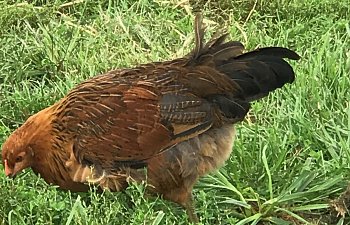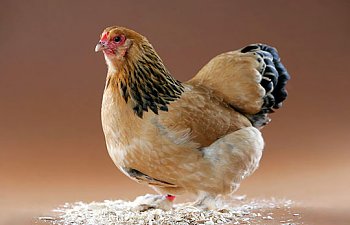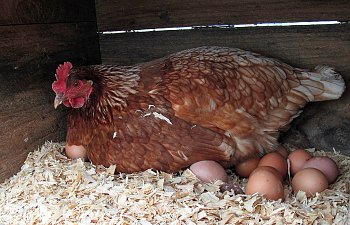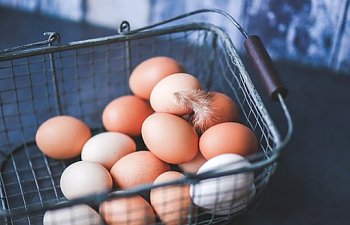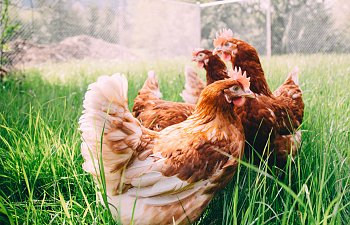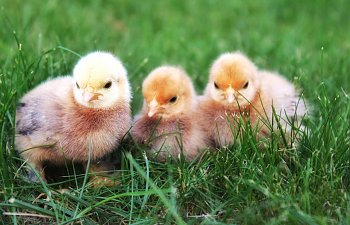Choosing The Right Breed For You
There is a lot to think about when choosing the breed of chicken that will work well in your area. Now that you have decided to get chickens and you determined the laws and ordinances in your area for owning chickens also known as fowl, Let’s get down to the fun stuff.
Choosing the right chickens!

The first thing to consider is size of chicken, Standard Large Fowl or Bantams? Standard Fowl are the typical full size chicken that everyone is used to seeing in your TV ads. Hens range in size from about 4 -10lbs. and Roosters will be from about 5 -13lbs. depending on the breed. They come in all colors, shapes, and sizes so look around and see what you are drawn to. Both standard and bantams will lay eggs of various colors depending on breed. Standard egg sizes range from small to X-large typically. Standard breeds take up a bit more space but lay larger eggs more frequently. The smaller standard fowl breeds will reduce feed consumption and cost.There is a lot to think about when choosing the breed of chicken that will work well in your area. Now that you have decided to get chickens and you determined the laws and ordinances in your area for owning chickens also known as fowl, Let’s get down to the fun stuff.
Choosing the right chickens!
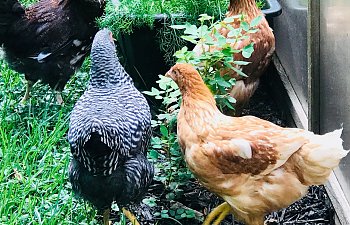
Bantams are smaller weighing just a couple pounds for both males and females at adulthood. There is a feathered leg and a clean leg variety. They consume less feed and are considered gentle and calm by nature. The downside is they only produce about 0-3 eggs per week and range in size from peewee to small. But if you do not want a lot of eggs this could be the right breed for you. They can make good mothers if want to breed because they are often broody but do not assume every breed of Bantam is. There are a few that are not. Additionally, Bantams do not do well in the heat so you would want to be from a cooler environment where temperatures do not soar in the summer or have high humidity. The other advantage is they do not take up much space so if you’re limited in space this could be the right one for you.
Second space is a factor. Standard fowl will need about 4 sq. ft. of space per bird in the coop and 10 sq. ft. of space in the run for adequate ventilation to reduce risk of illnesses and diseases. Many individuals feel that it is OK to reduce space if free range during the day but you have to think about those days when the chickens can not free range due to predators in area, rainy days, or snowy days when they will not want to venture out.
Thirdly the frequency of egg production is important to think about. You do not want to be inundated with eggs and nowhere to take them. If you are not commercial then you want to choose the amount that is right for your family to consume without a lot of surplus. So decide how many eggs you need a week. Three large standard fowl of the best layers will lay about 4-5 eggs per week plus or minus a few which will provide you about a dozen eggs per week. If you end up with surplus family, friends, and babysitters usually love some free eggs. These make great gifts! Occasionally a local farmers market or Tractor Supply Company will let you sell your eggs free of charge on their property when requested. Check for official applications or requests online or call ahead to check. Don’t forget there are many charitable organizations in your area soup kitchens, homeless shelters, etc. that provide meals for those in need and would be happy to take your surplus. Don’t forget those in need! Lastly, some have had success with storing surplus of eggs over the winter with dehydrated lime mixture in dry storage. You can investigate this on the Internet. I have not tried this yet.
Another consideration should be type of weather in your environment. Different breeds have various origins from different environments. Choose the breed that is right for your area. If you live in a hot zone down south, choose a breed that is Heat Tolerant. If you live in a cold area up north, look for one that is Very Cold Hardy. If you have hot summers and cold winters like me, you are going to look for a breed that is both Heat Tolerant and Cold Hardy so they are likely to survive and thrive in your environment. Heat and cold stress can lead to illness or death in a chicken. You also want to make this decision based on natural environment without addition of heat or air conditioning. Most breeds do not need these if you place them in an environment that is natural to them. Choosing outside of these recommendations may endanger the longevity of your chicken’s life. Also think about comb style or wattle size and risk for frostbite if in a very cold area. Some are more prone to this than others for example, the Ancona chicken. I would not get an Ancona chicken if live in a very cold area. Frostbite is painful and the chicken can lose part of their comb etc. Choose wisely!
Type of environment is important. Check to see if you can free range or not. If your laws and ordinances dictate confinement then you will have to look for a breed that does well in confinement without free range opportunities. If you have too many predators you may not want to free range for the safety of the bird. That said most breeds tolerate confinement or free range and some will thrive in these conditions. Check because of course there are some that may not tolerate both environments. Do your research!
Disposition is another factor to consider if have family with children, dogs, cats etc. around then you will want a friendly, docile, calm breed. It takes time to build a bond with your chickens. Starting with crumble in your hands when babies up to your chickens favorite treat in moderation as an adult. Don’t buy roosters that can be aggressive, they will chase, peck, or bite family members and may not be nice to the hens. Do not let roosters abuse your family or hens. If they are too aggressive, you can rehome them, sell them, or process for meat for the family if healthy birds.
Broodiness is something to think about. If you are banned by law from having roosters in your area or do not want them, then you will want to choose a breed that does not or rarely gets broody. When hens are broody, they stop laying eggs. If no fertilized eggs, then you will have to break the broodiness so the hen does not make themselves ill or stressed. You will only want a broody hen if you want to breed on your property for babies. This also requires a rooster. Broody mothers can make good mamas! Ask the breeder or hatchery for recommendations if not sure which hen would make a good mama because not all broody hens are. Also check breeding practices and care of roosters with hens before beginning. There is a lot more to consider here when keeping both.
The fun part is egg color and size. Do you want brown, white, blue, green, pink, just barely tinted eggs? Do you want peewee, small bantam, small, medium, large, X-large etc.? What is your pleasure? If you want to sell eggs, think about and research what eggs will sell best in your area. Color and size make a difference in sales believe it or not. If not selling, fill your egg basket with your personal favorites.
If you are starting new maybe choose Standard Fowl or Bantam but not both. It may take an experienced chicken keeper to make sure both do well in flock due to size differences and pecking order. Check out articles in the Learning Center at BYC before raising chickens and coop designs so that you are more versed before owning chickens. This includes articles on best predator protection. This makes a much more smooth transition. Learning Center Articles: https://www.backyardchickens.com/articles/
If you are adding to an existing flock, please honor 30-day quarantine for any new chickens to determine health of chickens before adding to a flock. You do not want to risk the health of your entire flock. Also, I highly recommend vaccinating for Marek’s Disease on day one of chickens life whether you bought from a Hatchery that vaccinates or not for all owners. See articles on Marek’s Disease and other common chicken diseases in the Learning Center so that you are well versed on the topic. If you are organic, it is still ok to vaccinate. This is a common disease that can wipe out your entire flock. Decide to feed medicated feed or not. Medicated feed prevents coccidiosis, which is another common chicken disease that can affect young chickens so an ounce of prevention is worth a pound of cure. If choose medicated feed then only need for first 8 weeks of life, then can switch over to non-medicated feed.
Lastly, I want to say investigate how to set up a brooder and what baby chicks need if you are purchasing one day olds. Need to have set up and ready to go 24 hours prior to arrival of your new little babies so the brooder has time to settle on an accurate temperature. We also recommend having your chicken coop set up or built by arrival of baby chickens so the coop has time to air out following set up. It takes just 4-5 short weeks for chickens to feather out and be ready for the great outdoors so you want to be ready too! Many hatcheries or breeders will sell started pullets that are just before laying age. These are adolescents and will be ready to lay in just a few more weeks so if you do not want to raise babies then think about started pullets. Have the coop ready and up before purchase. Check age of started pullets because everyone may sell them at different ages from 4 weeks on up to 16-20 weeks. There is something for everyone!
Oh, do not forget to decide if you want to be organic or not. There are plenty of resources to discuss organic chicken feeds and places that sell organic products most anywhere. It is a personal choice but you may want to make this decision before you bring your chicken’s home!
Attached is a chart on the common Standard and Bantam chicken breeds, their characteristics, and laying information in order to assist you in your breed choices There are also other helpful resources below.
Helpful Resources
Common Hatcheries:
https://www.backyardchickens.com/threads/poultry-hatcheries-list.1271562/
Breeders Directory:
https://www.backyardchickens.com/threads/byc-breeders-directory.1129376/
Common Best Layers in the United States:
https://www.mypetchicken.com/catalog/Our-Best-Layers-c67.aspx
Where you can find pictures with breed descriptions including babies and egg color:
https://www.meyerhatchery.com/get_subcat.a5w?cat=1020
https://www.backyardchickens.com/reviews/
Friendliest Birds:
https://www.mypetchicken.com/catalog/Friendliest-breeds-c116.aspx
Especially Cold Hardy:
https://www.mypetchicken.com/catalog/Especially-Cold-Hardy-c68.aspx
Especially Heat Hardy:
https://www.mypetchicken.com/catalog/Especially-Heat-Hardy-c69.aspx
Free Breed Selection Tool:
https://www.mypetchicken.com/chicken-breeds/which-breed-is-right-for-me.aspx
Free Baby Chick Identifier Photos:
https://www.mypetchicken.com/about-chickens/chicken-pictures/baby-chick-pictures.aspx

